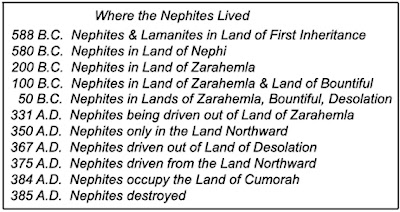Comment: "The Nephites did not live in Central America other than shorty after they arrived here; they lived primarily in Bountiful and Zarahemla."
Response: This is not correct. The Nephites, of course, that we know in the Book of Mormon did not live in Central America. However, to say they spent almost all their time in Zarahemla and Bountiful is inaccurate. Shortly after landing, maybe within a year or two, Nephi leaves the land of first inheritance and travels to a location his people called the Land of Nephi. This would have been somewhere around 585-580 B.C. The Nephites lived in that spot until about 200 B.C. when Mosiah was instructed to leave and traveled northward to a location where they found the city of Zarahemla. This means the Nephites lived in the Land of Nephi for almost 400 years That is about 40% of the entire time they spent in the Land of Promise.

For the first 550 years, the Nephites were never in the Land Northward
After that, they remained in Zarahemla until about 350 A.D. (expanding into Bountiful somewhere around 100 B.C. or a little earlier). Thus, they lived in Zarahemla and Bountiful from about 100 B.C. until around 350 A.D., when they lived entirely in the Land Northward, vacating the Land of Zarahemla and the Land of Bountiful when they were driven out by the Lamanites.
Comment: "This [Book of Mormon] is the record of the Nephites and their journeyings and not an analysis of the archaeological findings left by the apostate Lamanites, Jaredites, or some other unknown group which others haveused as a basis for their geography."
Response: Actually, the Lamanites and Jaredites occupied lands in the Land of Promise that were identical to the lands the Nephites occupied in various stages. Any artifacts left by the Jaredites or Lamanites would have basically mingled or merged with those of the Nephites. The most obvioius, however, would be the buildings of the Jaredites and the Nephites. We learned in the Land Northward, Limhi's people "traveled in a land among many waters, having discovered a land which was covered with bones of men, and of beats, and was also covered with ruins of buildings of every kind, having discovered a land which had been people with a people who were as numerous as the hosts of Israel" (Moiah 8:8).
We also know that just south of there, in the Land Southward, Nephi taught his people how to build very impressive buildings (2 Nephi 5:15-16). There was a temple in Bountiful (3 Nephi 11:1), and temples and sanctuaries and synagogues throughout the land, which were built after the manner of the ews (Alma 16:13; 26:29). We should keep in mind that the Jews did not build with wood,but built their temples out of rock and stone. Also, the Nephites in the Land Northward built their buildings out of cement, and built temple, synagogues and sanctuaries and all manner of building (Helaman 3:9,14).
The point of all th is is simply that any book about the Land of Promise must include the artifacts left behind by these civilizations, i.e., the Jaredites and the Nephites--and not just shards of vases, jewelry, etc., but buildings, temples, sanctuaries and synagogues in both the Land Southward and the Land Northward, built out of stone as did the Jews. We have no record, of course, that the Lamanites built anything, but of the Jaredites and Nephites, built extensively and in materials that would have survived over the centuries. For any writer of the Nephite history to be taken seriously, they must address these structures left behind, or his work will neither be complete, nor his maps and locations correct, for the Jaredites and later Nephites left the remains of extensive building, vast cities, roads, and many other things that would still, at least in part, be clearly evident today.
Nor can we say that Hugh Nibley would be correct in the Nephites not building important edifices, nor can we agree with him that they build out of wood, having palisades for walls, etc., and only mounds of heaped earth as a record of their passing. Such foolishness is to demean the Lord's people and lessen their abilities, which are extensively mentioned in the scriptural record.
Our final point--archaeology should never be used as the basis for the Land of Promise location. Nor should we rely upon statements given by modern man. The only true basis for this should be the scriptures themselves,the words of these ancient prophets,and the descriptions left for us by Mormon, who wrote for a future people which, of course, would be us living today!
(See the next post, "Did the Land of Promise Span Two Continents? Part VIII" for more on Covino's book and the website material)




No comments:
Post a Comment